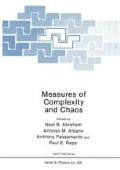Abstract
For continuous maps of the interval the transition to chaos (at least, in the sense of positive topological entropy) is always via the generation of periodic orbits of with periods which are powers of two. Discontinous maps of the interval allow considerably more freedom in the choice of a route to chaos, think of circle maps as maps of the interval, for example. Discontinuous maps of the interval arise naturally in the study of certain classes of flows, and here we wish to outline some of the phenomena associated with such maps and the corresponding flows they are intended to model. In particular, we shall concentrate on two sequences of bifurcations of periodic orbits. In the first sequence, described in section 3, there are bifurcations from period pn to period pn+l, (p0=1) accumulating at some value of the parameter in the problem. The second sequence (section 4) is more complicated; it is defined by p4(n+1)=4P4n+2, with p0=1, P4n+1=P4n+1, P4n+2=2P4n+1 and P4n+3=P4n+2−1 (so P4(n+1)=2P4n+3). There is a fundamental difference between these two sequences: the first is not really part of a transition to chaos whilst the accumulation point of the second sequence in parameter space is a new codimension two point on the boundary of chaos (although the precise sequence itself is not codimension two). This is only one example of the possible anharmonic routes to chaos which can arise in the classes of differential equations defined in the next section. Unfortunately, I know of no examples to date.
Access this chapter
Tax calculation will be finalised at checkout
Purchases are for personal use only
Preview
Unable to display preview. Download preview PDF.
References
J.M. Gambaudo, P. Glendinning, D.A. Rand and C. Tresser (1987) preprint. (See also J.M. Gambaudo (1987), Thesis, Université de Nice, and P. Glendinning ( 1985 ), Fellowship dissertation, University of Cambridge. )
J.M. Gambaudo, P. Glendinning and C. Tresser (1988) Nonlinearity, 1, 203.
P. Glendinning, J.E. Los, M.V. Otero-Espinar and C. Tresser (1989) A new concept in renormalisation group theory for dynamical systems, preprint.
P. Glendinning, J.E. Los, M. V. Otero-Espinar and C. Tresser (1989), in preparation
C. Tresser (1984) C.R. Acad. Sci. Serie 1, 299, 253.
I. Procaccia, S. Thomae and C. Tresser (1987) Phys. Rev. A, 35, 1884.
Author information
Authors and Affiliations
Editor information
Editors and Affiliations
Rights and permissions
Copyright information
© 1989 Plenum Press, New York
About this chapter
Cite this chapter
Glendinning, P. (1989). Time Series Near Codimension Two Global Bifurcations. In: Abraham, N.B., Albano, A.M., Passamante, A., Rapp, P.E. (eds) Measures of Complexity and Chaos. NATO ASI Series, vol 208. Springer, Boston, MA. https://doi.org/10.1007/978-1-4757-0623-9_42
Download citation
DOI: https://doi.org/10.1007/978-1-4757-0623-9_42
Publisher Name: Springer, Boston, MA
Print ISBN: 978-1-4757-0625-3
Online ISBN: 978-1-4757-0623-9
eBook Packages: Springer Book Archive

